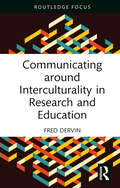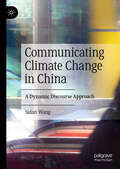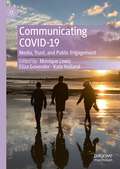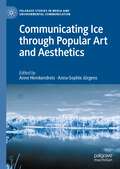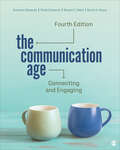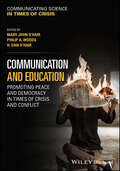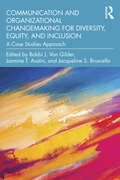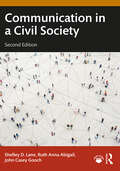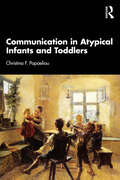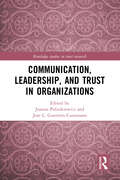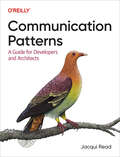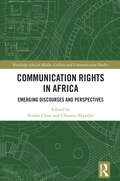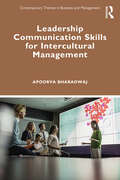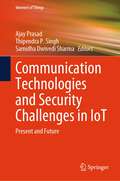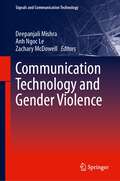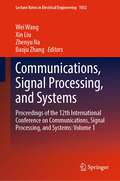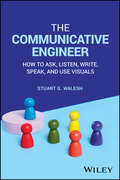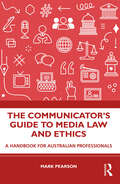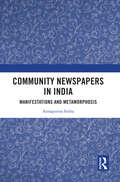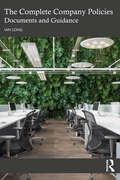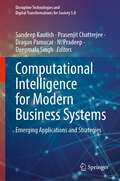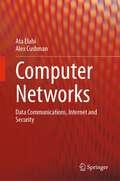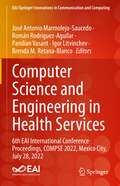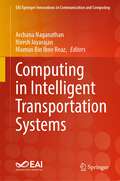- Table View
- List View
Communicating around Interculturality in Research and Education (New Perspectives on Teaching Interculturality)
by Fred DervinThis book does not instruct the reader how to communicate interculturally but supports them in reflecting on how they can (re-)negotiate and (re-)construct knowledge(s), ideologies and relations around the notion of interculturality. Anchored in the author’s original and thought-provoking perspectives on interculturality, this interdisciplinary and global-minded book explores how communicating around the notion cannot do away with ideologisms, issues of language and translation or the problematization of voice and silence in research and education. Written in an original and stimulating way, relying on different writing genres and styles to ‘mimic’ the dynamism and flexibility of the very notion under review, the author urges us to (un-)voice, scrutinize, nurture and galvanize our ways of dealing with interculturality alone and together with others in academia. The very specific focus of the book, communicating around interculturality (instead of ‘doing’ interculturality), represents a fresh and important move for observing, analyzing, speaking of and contributing to today's complex and divided world. The title is aimed at researchers, students and educators interested in examining and enriching their own takes on interculturality, from a more reflexive and interactive perspective.
Communicating Climate Change in China: A Dynamic Discourse Approach
by Sidan WangThis book explores how China's media narrate climate policy and climate change. With the rapid growth of economy and carbon emissions, China has been seen as having a key role in addressingclimate change and receives substantial attention from the media. In theChinese coverage, climate change issues can be interpreted as various concernsand ideas involving the dimensions of the economy, energy and emissions, publicinvolvement, science and ecology, and responsibility. In this sense, a discourseapproach can be used to understand how the newspapers construct the climatechange discourse and discourse networks in the coverage. This study selectsthree different newspapers in China, namely People’sDaily, China Daily and Southern Weekend. This book will interest scholars of Chinese politics, environmentalists, and media studies scholars.
Communicating COVID-19: Media, Trust, and Public Engagement
by Monique Lewis Eliza Govender Kate HollandThis edited collection, follows on from 'Communicating COVID-19: Interdisciplinary Perspectives' (2021) and brings together different scholars from around the world to explore and critique the ongoing advances of communicating COVID, two years into the pandemic. Pandemic life has become familiar to us, with all its disruptions and uncertainties. In the second year of COVID, many societies emerged well attuned to new waves of infections, while others, having initially demonstrated 'gold standard' responses, regressed, either through a premature end to public health restrictions or challenges around vaccine rollouts. In many countries, bitter social divisions have arisen over mask-wearing, lockdowns, quarantine and vaccination. To better understand the ever evolving communicative landscape of COVID-19, this collection shares updated perspectives from the disciplines of media and communication, journalism, public health and primary care, sociology, and political and behavioural science, addressing the major issues that have confronted communicators, including vaccine hesitancy, misinformation, and the mobilisation of community driven communication responses as restrictions eased in various parts of the world.
Communicating Ice through Popular Art and Aesthetics (Palgrave Studies in Media and Environmental Communication)
by Anne Hemkendreis Anna-Sophie JürgensThis book brings together the perspectives of eminent and emerging scholars from fields as varied as science communication, art history, pop cultural studies, environmental studies, sciences studying ice and artists to explore the power of (popular) arts and aesthetics to communicate ice research and the urgency of environmental action. Examining the aesthetic strategies employed in images, (popular) visual fiction and narratives to convey meaning and awareness – and how they can be made fruitful for science communication – the project will generate new perspectives on how our collective environmental responsibility can be addressed and communicated across disciplines and divers audiences. In doing so, the volume will illuminate the cultural power of ice research and contribute to a better understanding of the cultural work that emerges from our ecological crisis.
The Communication Age: Connecting and Engaging
by Autumn Edwards Shawn T. Wahl Scott A. Myers Chad C. EdwardsWhen should you send a text message, and when is it more appropriate to talk face-to-face? What is the best way to prepare for a job interview that will be conducted over video? How should you modify your speech if it will be recorded and posted online? The Communication Age: Connecting and Engaging introduces students to the foundational concepts and essential skills of effective communication, with a strong emphasis on the impact of technology in our increasingly interconnected world. This new Fourth Edition helps students become involved in our diverse global community and learn how to apply key principles of effective communication—whether incorporating media, technology, or traditional face-to-face speech communication—to foster civic engagement for a better future. With comprehensive coverage of the essentials of interpersonal, small group, and public communication, this text is ideal for use in hybrid introduction to communication courses.
The Communication Age: Connecting and Engaging
by Autumn Edwards Shawn T. Wahl Scott A. Myers Chad C. EdwardsWhen should you send a text message, and when is it more appropriate to talk face-to-face? What is the best way to prepare for a job interview that will be conducted over video? How should you modify your speech if it will be recorded and posted online? The Communication Age: Connecting and Engaging introduces students to the foundational concepts and essential skills of effective communication, with a strong emphasis on the impact of technology in our increasingly interconnected world. This new Fourth Edition helps students become involved in our diverse global community and learn how to apply key principles of effective communication—whether incorporating media, technology, or traditional face-to-face speech communication—to foster civic engagement for a better future. With comprehensive coverage of the essentials of interpersonal, small group, and public communication, this text is ideal for use in hybrid introduction to communication courses.
Communication and Education: Promoting Peace and Democracy in Times of Crisis and Conflict (Communicating Science in Times of Crisis)
by Mary John O᾿Hair Philip A. Woods H. Dan O᾿HairA timely and insightful exploration of the vital relationships among effective communication, education, peace, and democracy Communication and Education: Promoting Peace and Democracy in Times of Crisis and Conflict explores the complexities of addressing divisive societal challenges, reducing conflicts, and building and sustaining peace and democracy around the world. Contributions by an international panel of experts provide evidence-based practices, findings from ongoing research projects, policy analyses, and cutting-edge theories, frameworks, and models for confronting global challenges to peace and democracy. Examining the crucial role of crisis communication and education on a global scale, this research-based compendium covers a broad range of key topics, such as democratizing education, promoting peace through complexity science, understanding how factionalism threatens democracy, encouraging citizen participation, and more. Throughout the text, the authors highlight the need for equity, compassion, critical thinking, and active engagement to create a sustainable future based on democratic values. Designed to enhance the knowledge base of crisis communication related to crises impacting education, peace, and democracy, Communication and Education: Explores different strategies and practices for fostering democracy in education, such as the IDEALS framework for creating positive school cultures Discusses emotional geographies in schools and their impact on democratic school climate and teacher burnout Emphasizes empathic communication and participatory skills among teachers Offers practical strategies and examples of harnessing technology for peace and democracy Provides real-world case studies illustrating the transformative power of education, music, diverse perspectives, and open communication channels Examines the ecological interdependence of effective communication, education, democracy and peace Part of the Wiley Blackwell Communicating Science in Times of Crisis series, Communication and Education: Promoting Peace and Democracy in Times of Crisis and Conflict is essential reading for communication and education scholars, researchers, students, practitioners, and community scientists.
Communication and Organizational Changemaking for Diversity, Equity, and Inclusion: A Case Studies Approach
by Van Gilder, Bobbi J. Jasmine T. Austin Jacqueline S. BruscellaThis book explores the opportunities, challenges, and effective approaches to organizational change regarding diversity, equity, inclusion, and belonging. Featuring application-based case studies and practical guidelines for meaningful organizational change, this book problematizes some of the current DEI initiatives in today’s organizations. It examines multiple forms of diversity (e.g., race, age, and mental health) from a variety of perspectives (e.g., leadership and employee), with case studies that demonstrate how changemaking efforts can be reimagined and implemented in better, more nuanced, and more sustainable ways to produce meaningful organizational change. Through these case studies, readers learn from organizations’ successes and failures in their attempts to implement DEI practices. Each chapter concludes with explicit practical implications and/or actionable recommendations for organizational changemaking. This text will make an impactful addition to courses in communication and diversity or organizational communication/change at the advanced undergraduate or graduate level, and will be an essential guide for professionals wishing to lead change in their organizations.
Communication in a Civil Society
by Shelley D. Lane Ruth Anna Abigail John Casey GoochUsing the concept of “civility” as the major theme, this fully updated second edition offers a unique and alternative way to teach and learn about communication.The book brings together discrete areas that explore the fundamentals of communication and intrapersonal communication, interpersonal communication, small group communication, and public speaking. Every chapter includes theories, concepts, and examples that allow students to use civil and ethical communication skills in their personal relationships, in collaboration with colleagues, and in giving public speeches and professional presentations. This new edition highlights advances in and concepts related to mediated and technology-based communication, such as chatbots, technostress, and dating apps, and shows how students can engage in civil face-to-face and mediated interaction. Additionally, each chapter includes a real-world incident that students are asked to analyze in terms of specific chapter information and skills related to civility.Communication in a Civil Society is an ideal textbook for Introduction to Communication, Interpersonal Communication, and Public Speaking courses.Materials for instructors including PowerPoint slides, a test bank, and an instructor’s manual, are available at www.routledge.com/9781032513263.
Communication in Atypical Infants and Toddlers
by Christina F. PapaeliouThis book presents a comparative review of the latest studies and data on prelinguistic communication and early semantic development in autism spectrum disorder (ASD), Williams syndrome (WMS), attention-deficit/hyperactivity disorder (ADHD), and early language delay. Papaeliou offers a critical analysis of the literature, compares key theoretical approaches, and interprets data on development in atypical populations.A fruitful synthesis of theory and research reveals that, instead of cognitive deficits, the core feature of these neurodevelopmental disorders consists of deficits in the ability for self- and intersubjective coordination, which adversely affects early interactions and, consequently, the emergence of language. The book composes fragmentary proposals on the role of rhythm disruptions in different conditions, setting out the idea that disruption in interactional synchrony is a connecting thread through neurodevelopmental disorders which show high prevalence or high comorbidity rates. Papaeliou identifies distinct communicative patterns characteristic of each disorder and puts forward a unifying theory for interpreting data on early communication and language development in atypical populations.This is ideal reading for psychologists, psycholinguists, psychiatrists, paediatricians, speech therapists, and special educators. Students in developmental psychology and anyone interested in understanding the research behind typical and atypical development will also benefit from this text.
Communication, Leadership and Trust in Organizations (Routledge Studies in Trust Research)
by Joanna Paliszkiewicz Cusumano, Jose L. GuerreroTrust in communication and leadership is the key to success in business. This book presents and discusses the main issues and challenges posed by communication, leadership, and trust. The first part of the book describes the communication and trust issues, the second part presents the role of trust in leadership, and the third part describes different examples of implementing trust to organizations. Readers will gain from this book theoretical and practical knowledge of communication, leadership, and trust; empirically validated practice regarding trust and its related concepts; and a novel approach for addressing this topic. This book can be used as a toolbox to improve understanding and opportunities related to building trust in organizations and will be especially valuable for students and researchers in the fields of leadership, organizational communication, business ethics, and trust research.
Communication Patterns
by Jacqui ReadHaving a great idea or design is not enough to make your software project succeed. If you want stakeholders to buy into your design and teams to collaborate and contribute to the vision, you also need to communicate effectively. In this practical book, author Jacqui Read shows you how to successfully present your architecture and get stakeholders to jump on board.Misunderstanding and lack of buy-in leads to increasing costs, unmet requirements, and an architecture that is not what you intended. Through constructive examples and patterns, this book shows you how to create documentation and diagrams that actually get the message across to the different audiences you'll face.This book shows you how to:Design diagrams and documentation appropriate to your expected audience, intended message, and project stageCreate documentation and diagrams that are accessible to those with varying roles, needs, or disabilitiesMaster written, verbal, and nonverbal communication to succeed in technical settingsApply the communication patterns presented in this book in real-world projects and software designsCommunicate and collaborate with distributed teams to successfully design and document software and technical projects
Communication Rights in Africa: Emerging Discourses and Perspectives (Routledge African Media, Culture and Communication Studies)
by Tendai Chari Ufuoma AkpojiviThis ground-breaking volume examines enduring and emerging discourses around communication rights in Africa, arguing that they should be considered an integral component of the human rights discourse in Africa. Drawing on a broad range of case studies across the continent, the volume considers what constitutes communication rights in Africa, who should protect them, against whom, and how communication rights relate to broader human rights. While the case studies highlight the variation in communicative rights experiences between countries, they also coalesce around common tropes and practices for the implementation and expression of communication rights. Deploying a variety of innovative theoretical and methodological approaches, the chapters scrutinise different facets of communication rights in the context of both offline and digital communication realities. The contributions provide illuminating accounts on language rights, digital exclusion, digital activism, citizen journalism, media regulation and censorship, protection of intellectual property rights, politics of mobile data, and politicisation of social media. This is the first collection to consider communication in Africa using a rights-based lens. The book will appeal to researchers, academics, communication activists, and media practitioners at all levels in the fields of media studies, journalism, human rights, political science, public policy, as well as general readers who are keen to know about the status of communication rights in Africa.
Communication Skills for Global Leadership: Strategies for Effective Intercultural Management (Contemporary Themes in Business and Management)
by Apoorva BharadwajIntercultural business communication has assumed enormous significance in recent times for corporate leaders for transmitting and disseminating ideas across borders and for achieving organisational goals. This book provides a comprehensive introduction to communication strategies in business with a focus on diversity management skills.Culturally congruent communication competencies play an essential role in fostering productive conversations in transnational markets. This book includes in-depth research that explores key communication skills like negotiations, leadership, persuasion, argumentation, and corporate etiquette for professionals working in multinational realms of international commerce. It discusses intercultural management theories, non-verbal communications, and effective methods of communicating in virtual environments. The book also highlights the role and importance of diversity management in steering and helming multicultural teams and the expertise needed to manage stressful and challenging communication scenarios in variegated geo-cultural workspaces.Part of the Contemporary Themes in Business and Management series, this book will be useful for scholars and researchers of management studies, business communications, communication studies, business economics, business ethics, and digital communication, as well as for corporate professionals working with multinationals.
Communication Technologies and Security Challenges in IoT: Present and Future (Internet of Things)
by Ajay Prasad Thipendra P. Singh Samidha Dwivedi SharmaThis book presents overall communication technologies and protocols used in IoT like in networks: Wi-Fi, Bluetooth, Zigbee, LoRA, GSM/GPRS/EDGE/LTE, etc. in applications: MQTT, CoAP, AMQP, XMPP, etc, focusing on the architecture and threat perseverance of each. The book also presents new/future technological additions like Wi-Fi HaLow (802.11ah), HEW (802.11ax), BLE, NFC, RFID, etc.,) and upcoming changes in communication systems in IoT and its possible security aspects. The book also covers security aspects in communication mechanisms in domain-specific IoT solutions for healthcare, smart cities, smart homes, smart vehicles, etc. The objective of the book is to assist IoT developers to have a good insight into available and upcoming communication technologies so that they can employ the best possible practices while designing and developing IoT solutions.
Communication Technology and Gender Violence (Signals and Communication Technology)
by Deepanjali Mishra Anh Ngoc Le Zachary McDowellThis book presents a compilation of case studies from practitioners, educators, and researchers working in the area of digital violence, along with methodologies to prevent it using cyber security. The book contains three basic sections namely: the concept of digital violence in policy and practice; the impact of digital violence; and the implication of cyber security to curb such violence. The intention of this book is to equip researchers, practitioners, faculties, and students with critical, practical, and ethical resources to use cyber security and related technologies to help curb digital violence and to support victims. It brings about the needs of technological based education in order to combat gendered crimes like cyberbullying, body-shaming, and trolling that are a regular phenomenon on social media platforms. Topics include societal implications of cyber feminism; technology aided communication in education; cyber security and human rights; governance of cyber law through international laws; and understanding digital violence.
Communications, Signal Processing, and Systems: Proceedings of the 12th International Conference on Communications, Signal Processing, and Systems: Volume 1 (Lecture Notes in Electrical Engineering #1032)
by Wei Wang Xin Liu Zhenyu Na Baoju ZhangThis book brings together papers presented at the 2023 International Conference on Communications, Signal Processing, and Systems, which provides a venue to disseminate the latest developments and to discuss the interactions and links between these multidisciplinary fields. Spanning topics ranging from Communications, Signal Processing, and Systems, this book is aimed at undergraduate and graduate students in Electrical Engineering, Computer Science and Mathematics, researchers and engineers from academia and industry as well as government employees (such as NSF, DOD, DOE).
The Communicative Engineer: How to Ask, Listen, Write, Speak, and Use Visuals
by Stuart G. WaleshTHE COMMUNICATIVE ENGINEER Application-oriented communication guidebook designed for engineering students and practitioners to improve their asking, listening, writing, speaking, and use of visuals Practicing engineers spend about half their time communicating ideas, facts, and feelings but invest only a small part of their formal education learning how to communicate. The Communicative Engineer addresses this gap. When used as a textbook for students or resource for practitioners, this book shows engineers in all disciplines how to use five communication modes—asking, listening, writing, speaking, and visuals—to participate in or lead successful engineering projects and achieve professional success and significance. Written by a highly qualified author with six decades of relevant experience, The Communicative Engineer: Illustrates, using examples, the benefits of communication knowledge, skills, and attitudes (KSA) and the costs of poor communicationPresents communication fundamentals and goes well beyond theory by illustrating numerous applicationsDescribes the five modes of communication, including their pros and cons, and offers detailed advice on when and how to use themPrepares readers to use or participate in various communication forms such as interviews, letters, meeting minutes, memoranda, oral examinations, proposals, question and answer sessions, reports, resumes, speeches, and texts Profiles excellent engineer communicators to serve as exemplars and references memorable speeches from within and outside of engineering to provide examplesProvides thorough documentation of content for readers who want to dig deeper into selective aspects of communication Supplementing the scientific and technical education of engineers, The Communicative Engineer offers engineering students and practitioners in all disciplines the parallel communication KSA needed to fully realize their potential. Given technology’s ever-increasing role in society, the communicative engineer will be prepared to fill leadership roles.
The Communicator's Guide to Media Law and Ethics: A Handbook for Australian Professionals
by Mark PearsonThis book offers an introduction to the key legal and ethical topics confronting Australian journalists and strategic communicators both at home and internationally and offers a suite of reflective techniques for navigating them. It starts by positioning morals, ethics, and the law in their historical and philosophical frameworks by tracing the evolution of free expression and professional media ethics. Media law and ethics are then contextualized in their modern international human rights framework. Readers are equipped with a skill set for reflecting on the law and ethics of professional media dilemmas – including mindful reflection, the Potter Box, journaling, concept mapping, and discussion. Such approaches are then applied to key topic areas, including free expression; reputation; confidentiality; privacy; justice; intellectual property; national security; discrimination and harassment; and conflicted interests. Each is examined in terms of its philosophical underpinnings, relationship to human rights, professional ethical context, international examples, legal principles, key Australian laws, legal cases, and strategies for applying reflective practice techniques. It concludes on a confident note – imploring communicators to engage in constructive and mindful strategic communication with the authority and confidence that results from a working knowledge of media law and ethics. This handbook is for professional communicators and students in all fields, but particularly in journalism, public relations, corporate communication, media relations, and marketing.
Community Newspapers in India: Manifestation and Metamorphosis
by Annapurna SinhaThis book provides a comprehensive account of community newspapers in India discussing their reach, practices, management and influence on communities. It focuses on the core characteristics associated with community media, such as access and participation, advocacy and self-management among other. With the help of detailed case studies of two established newspapers – Khabar Lahariya and Namaskar, the book highlights the unique aspects of their rhizomatic expansion and the practices for social change. By examining their manifestations and metamorphosis, the book shows how community media is fluid and evolves with time owing to diverse motivations. The author also examines themes such as media democracy and citizens engagement; role of alternative media and the diversity of practices and profiles to highlight the relevance, identity and purpose of alternative media in general and community newspapers in particular. This book will be of interest to scholars and researchers of media studies, journalism and mass communication, political studies, development studies, law and South Asian studies. It will also be useful to NGOs and CSOs working in the areas of community engagement, social development and empowerment, and literacy.
The Complete Company Policies: Documents and Guidance
by Ian LongThis book is about a much neglected but essential element of the success of any business: company policy. This is a comprehensive guide to determining what policies your company needs, and how to draft and approve the relevant documents and implement them throughout the organization. From anti-bribery laws to data privacy and health and safety, your business is faced with a range of legal and regulatory obligations that must be identified and documented properly. These obligations must be addressed for internal and external stakeholders. The task of identifying and documenting effective policies is an essential step in establishing good corporate governance and ultimately a culture of compliance. These policies in turn provide a solid foundation for the reputation and commercial success of the organization, and form an essential "bridge" between the company’s strategy and the various procedures needed to carry it out. With many useful templates and practical examples, this book will help you to ensure the accuracy and completeness of your policy documents. It covers all areas of your business, including financial reporting, anti-money laundering, anti-fraud, conflicts of interest, data privacy and security, remote working, social media, whistleblowing, and more.This book will be useful to company directors, company secretaries and senior managers, and their advisers, including consultants, auditors, and solicitors. It will be particularly relevant to any business that needs to create or review their policies in light of current regulations and standards.
Computational Intelligence for Modern Business Systems: Emerging Applications and Strategies (Disruptive Technologies and Digital Transformations for Society 5.0)
by Sandeep Kautish Prasenjit Chatterjee Dragan Pamucar N. Pradeep Deepmala SinghThis book covers the applications of computational intelligence techniques in business systems and advocates how these techniques are useful in modern business operations. The book redefines the computational intelligence foundations, the three pillars - neural networks, evolutionary computation, and fuzzy systems. It also discusses emerging areas such as swarm intelligence, artificial immune systems (AIS), support vector machines, rough sets, and chaotic systems. The other areas have also been demystified in the book to strengthen the range of computational intelligence techniques such as expert systems, knowledge-based systems, and genetic algorithms. Therefore, this book will redefine the role of computational intelligence techniques in modern business system operations such as marketing, finance & accounts, operations, personnel management, supply chain management, and logistics. Besides, this book guides the readers through using them to model, discover, and interpret new patterns that cannot be found through statistical methods alone in various business system operations. This book reveals how computational intelligence can inform the design and integration of services, architecture, brand identity, and product portfolio across the entire enterprise. The book will provide insights into research gaps, open challenges, and unsolved computational intelligence problems. The book will act as a premier reference and instant material for all the users who are contributing/practicing the adaptation of computational intelligence modern techniques in business systems.
Computer Networks: Data Communications, Internet and Security
by Ata Elahi Alex CushmanThe hands-on textbook covers both the theory and applications of data communications, the Internet, and network security technology, following the ACM guideline for courses in networking. The content is geared towards upper undergraduate and graduate students in information technology, communications engineering, and computer science. The book is divided into three sections: Data Communications, Internet Architecture, and Network Security. Topics covered include flow control and reliable transmission; modulation, DSL, cable modem, and FTTH; Ethernet and Fast Ethernet; gigabit and 10 gigabit Ethernet; and LAN interconnection devices, among others. The book also covers emerging topics such as IPv6 and software defined networks. The book is accompanied with a lab manual which uses Wireshark, Cisco Packet Tracer, and virtual machines to lead students through simulated labs.
Computer Science and Engineering in Health Services: 6th EAI International Conference Proceedings, COMPSE 2022, Mexico City, July 28, 2022 (EAI/Springer Innovations in Communication and Computing)
by José Antonio Marmolejo-Saucedo Román Rodríguez-Aguilar Pandian Vasant Igor Litvinchev Brenda M. Retana-BlancoThis book constitutes the refereed post-conference proceedings of the 6th EAI International Conference Computer on Science and Engineering in Health Services (COMPSE 2022), which took place in Mexico City and online, June 28th, 2022. The papers are grouped on thematic topics: application of tools delivered by the COVID-19 pandemic; health services; computer and data science; and industry 4.0 in logistics and supply chain. The content is relevant to researchers, academics, students and professionals.
Computing in Intelligent Transportation Systems (EAI/Springer Innovations in Communication and Computing)
by Archana Naganathan Niresh Jayarajan Mamun Bin Ibne ReazThis book presents various application areas of computing in the automotive sector. The authors explain how computing enhances the performance of vehicles, covering the applications of computing in smart transportation and the future scope. The authors focus on computing for vehicle safety in conjunction with the latest technologies in Internet of Things (IoT). The book provides a holistic approach to computing in an inter-disciplinary and unified view. Topics covered include driverless automated navigation systems, smart transportation, self-learning systems, in-vehicle intelligent systems, and off-road vehicle diagnosis and maintenance, among others. The authors include simulated examples and case studies for better understanding of the technologies and applications. The book is intended for a wide range of readers from students to researchers and industry practitioners and is a useful resource for those planning to pursue research in the area of computing and autonomous driving vehicles.
